Cumbria orchid is a plant variety that has been bred artificially and cannot be found in the wild, because it was created only for indoor reproduction. Phalaenopsis is characterized by green foliage, thin roots and pseudobulbs, which should be rounded. They are needed for the accumulation of nutrients, as they help to survive in extreme conditions and therefore have a good effect on the development of the flower. On one peduncle there may be several buds that bloom gradually. Sizes of flowers are found from 4 to 9 cm in various colors. Orchid blooms last all year. The care and propagation of such flowers is simple, and they adapt well to the environment.
Content
Views and descriptions
Because of the many varieties of orchids, you can find flowers suitable for each grower. There are several popular varieties, which include:
- Beallara - this hybrid is obtained from 4 varieties of orchids (Miltonia, Brassia, Odontoglossum, Kohlioda).
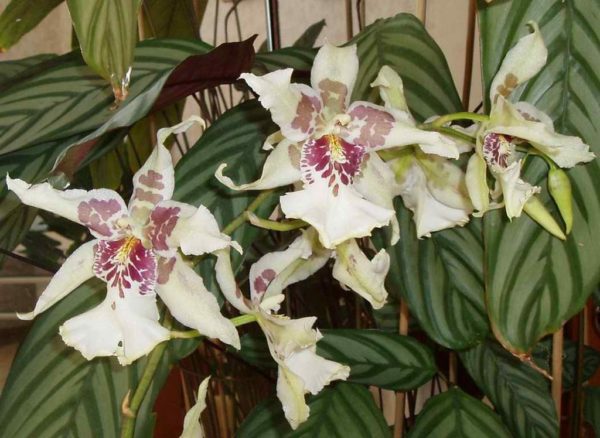
Beallara Flowering occurs in the summer. Orchids are found in cream or pink flowers with dark spots.
- Burrageara - This hybrid is obtained from 4 varieties of orchids (Miltonia, Ontsidium, Odontoglossum and Kohlioda).
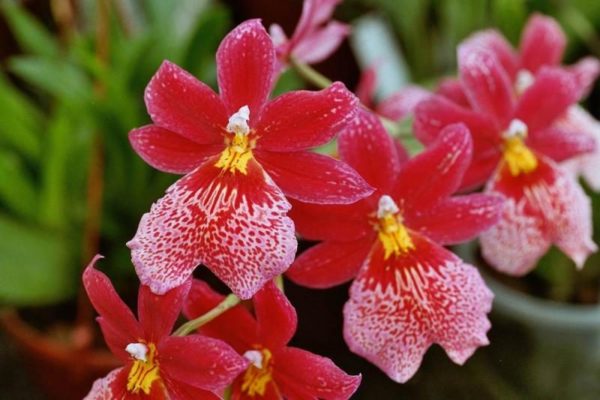
Burrageara Flowering occurs in winter. The inflorescence of the flower consists of yellow and red flowers.
- Colmanara - This hybrid is obtained from 3 varieties of orchids (Odontoglossum, Miltonia and Oncidium).
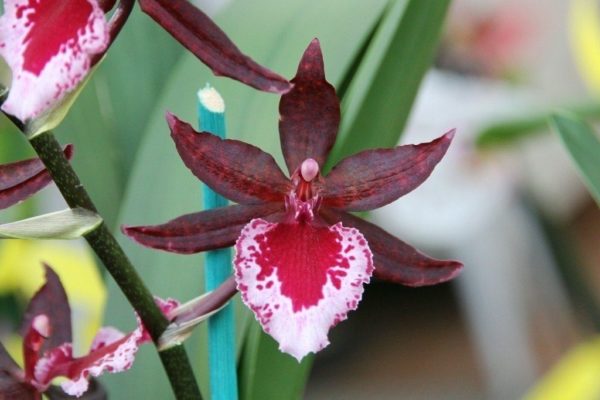
Colmanara The duration of flowering is 2 months. A long flower arrow can have up to 20 flowers.
- Vuilstekeara - obtained from 3 varieties of orchids (Odontoglossum, Kohlioda and Miltonia).
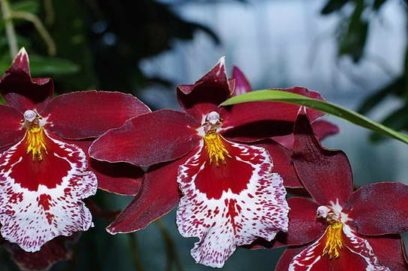
Veilstekeara Flowering occurs at the end of winter and the beginning of summer. The duration of flowering is 6 weeks. A long flower arrow can have 15 flowers.
Growing conditions
For the development of Cumbria, orchids must be kept in suitable conditions. In addition, it should be borne in mind that individual care is acceptable for each variety.
Cumbria is a photophilous plant and therefore needs good illumination. But it should not be put where the possibility of obtaining ultraviolet radiation is great, otherwise the plant will get burned. This will be visible if the leaf turns yellow. If in winter the orchid receives insufficient lighting, then it is supplemented with phytolamps. When the orchid is at rest, it does not need a lot of light.
Orchids can grow in a cool, intermediate and warm climate. Cumbria belongs to the first type, so its suitable temperature is considered to be from 10C to 30C. If the temperature is not observed, the flower will fall ill and die. Night and winter temperatures are 12 degrees, and summer temperatures are 20-24 degrees. Sometimes, for a better growth of flowers, they are subjected to a temperature difference, but this is not necessary for this hybrid.
Cumbria are susceptible to fungal infections, and therefore they are not recommended for spraying. This plant does not need a hot shower, if only once a month and in the warmer months, in order to get rid of dust, to wash the soil from salt deposits and from the remaining fertilizers.
It is believed that due to low humidity, the leaves wrinkle, but this happens in a complex when the temperature is high and the humidity is low.
Boarding and transplanting after purchase
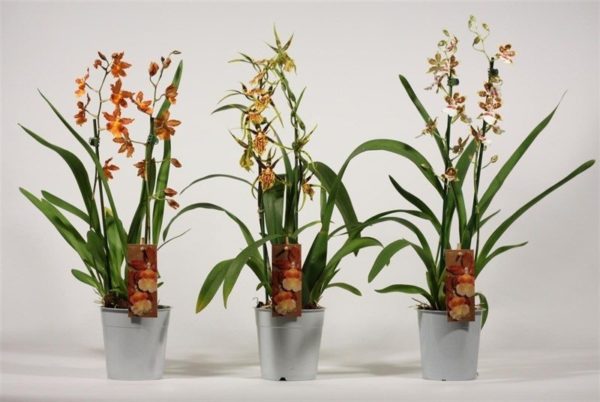 Cumbria does not need to be constantly transplanted. This is necessary when the roots peek out of the pot, and the soil is stale. To transplant a flower, this requires ordinary land. If the room has dry air, then add perlite to the soil, which helps maintain moisture in the ground. It is necessary to put drainage at the bottom of the tank, and drain holes on the walls for better ventilation of the roots.
Cumbria does not need to be constantly transplanted. This is necessary when the roots peek out of the pot, and the soil is stale. To transplant a flower, this requires ordinary land. If the room has dry air, then add perlite to the soil, which helps maintain moisture in the ground. It is necessary to put drainage at the bottom of the tank, and drain holes on the walls for better ventilation of the roots.
An orchid transplant is necessary if there is a problem with the root system, which occurs due to frequent watering. After purchase, the plant must be moved to a permanent pot. The transplant is carried out in the following order:
- Carefully remove the plant from the container. If it has already been transplanted, then do not touch the root system, and if the flower was bought in a store, then it must be well cleaned of soil. It is especially worthwhile to look carefully at the middle of the coma, as there may be a peat cup, a lump of moss and pieces of foam.
- It is necessary to get rid of dead pseudobulbs. If the roots are damaged, remove them, and cuts should be sprinkled with crushed coal. After the plant needs to be dried.
- At the bottom of a new pot, put tree bark, and place soil for Cumbria on top.
- Plant the orchid in a new pot, gently spread the roots and fill it with the remaining soil. It will not be superfluous to knock on the walls of the tank so that the drainage is evenly distributed. The pseudobulb should be located at the top of the soil.
- when a plant is transplanted, you need to make sure that it has hardened in the soil. So that planted Cumbria does not stagger, tie it to the props.
The plant does not need to be watered after transplantation. During this time, the roots are saturated with nutrients, and the wounds can heal.
Home Care
 It does not require much effort. To properly care for Cumbria at home, you need to follow the rules.
It does not require much effort. To properly care for Cumbria at home, you need to follow the rules.
Unlike other orchids, Cumbria does not like much moisture. The flower does not need much transfusion, otherwise the rotten root system will not be subject to salvation, it will be difficult to reanimate the culture. Therefore, the orchid should be watered when the soil is completely dry. But do not forget about hydration. If the pseudobulbs are wrinkled, then all useful substances have ended in them and the flower needs to be watered. There is a specific watering mode:
- In the summer it needs to be carried out every week. If it is very hot, then the time between watering is reduced.
- In winter, if the room is not yet heated, and it gets colder outside, then the plant is watered every 2 weeks.
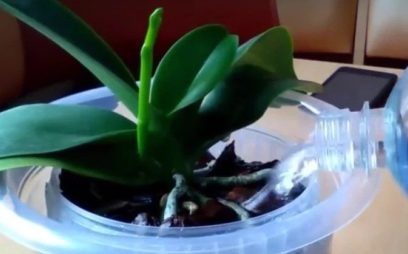 A suitable way for watering an orchid is considered to be 1/3 immersion in water. In the summer, the flower is saturated with water in 20 minutes, in winter this time is reduced to 5 minutes. For irrigation, warm and filtered water is used.
A suitable way for watering an orchid is considered to be 1/3 immersion in water. In the summer, the flower is saturated with water in 20 minutes, in winter this time is reduced to 5 minutes. For irrigation, warm and filtered water is used.
When young shoots appear on a flower, then top dressing is needed. The roots of Cumbria are gentle and easy to damage, to avoid this you need to use a non-concentrated composition of the fertilizer. Top dressing can be applied no more than twice a month from March to September, by lowering the container into a solution with a small amount of fertilizer. Fertilization should be stopped at the time of flowering, and the accumulated nutrients will be enough for this period.
Pruning is carried out exclusively for dry leaves and faded stems. Such a hybrid does not have a rest period. But growth retardation is manifested in autumn and winter with decreasing temperature. At this time, reduce the watering of the flower and cancel feeding, but in the spring, do everything in the usual mode, when the development of culture resumes.
Bloom
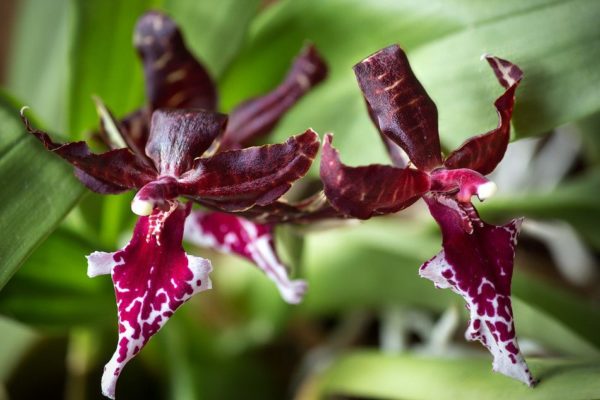 Cumbria blooms in autumn and winter. Bulba appears on the shoot in spring and summer, and the peduncle begins to appear in the axils of the leaves.Additionally, lighting is used to give color to the orchid and increase the flowering time. But what if Cumbria does not bloom for several years? To do this, it is necessary to reduce the frequency of watering at the time of bulb formation. After it forms a flower can not be watered for several weeks. Because of these actions, Cumbria will grow better. When several peduncles appear, then it's time to resume watering again.
Cumbria blooms in autumn and winter. Bulba appears on the shoot in spring and summer, and the peduncle begins to appear in the axils of the leaves.Additionally, lighting is used to give color to the orchid and increase the flowering time. But what if Cumbria does not bloom for several years? To do this, it is necessary to reduce the frequency of watering at the time of bulb formation. After it forms a flower can not be watered for several weeks. Because of these actions, Cumbria will grow better. When several peduncles appear, then it's time to resume watering again.
Stimulation of the plant occurs by reducing the night temperature to 15 ° C for 2 weeks. Young flowers are better not to undergo such a procedure, but to allow them to be saturated with nutrients. Many flower growers advise reducing the frequency of watering during the maturation of pseudobulbs, allowing them to grow. After a while, the plant is watered and then stopped again. This may cause the flower arrow to drop.
Breeding
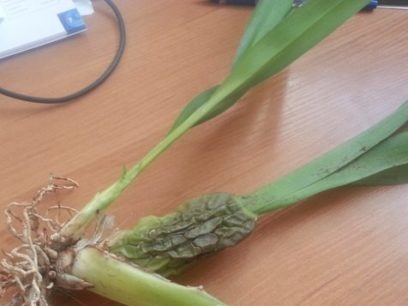 The division of Cumbria occurs after it has faded. First you need to pull the orchid out of the pot and get rid of the soft earth. Inspect the roots and, if there are defective areas, get rid of them. Cumbria is divided into several parts, and the slices are sprinkled with wood ash. After that, the separated part is used for landing in another container.
The division of Cumbria occurs after it has faded. First you need to pull the orchid out of the pot and get rid of the soft earth. Inspect the roots and, if there are defective areas, get rid of them. Cumbria is divided into several parts, and the slices are sprinkled with wood ash. After that, the separated part is used for landing in another container.
To propagate the orchid, you can use her children. When they appear on the mother bush they need to be carefully cut off. An orchid can be placed in a solution with a growth stimulator, and when roots are formed, the Cumbria sprout can be transplanted into a closed system. You can also plant children immediately in the ground.
Reproduction of the cumbria orchid, landing and transplanting considered easy for any grower.
Common problems
Fungal diseases and various types of rot arise from a large amount of moisture on the roots, and bacterial infections appear due to sucking pests. If the leaves turn yellow, then this means that the orchid is sick and should:
- pull it out of the pot;
- leave it in a dry place for the whole day;
- dry the roots;
- apply fertilizer;
- transplant the orchid in a new soil, after the roots have completely dried.
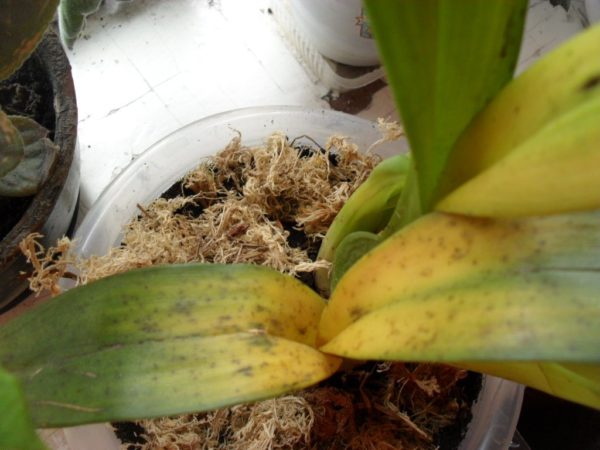 If the leaves turn yellow, then this is affected by a lack of nutrients in the soil, and the plant begins to shed old leaves.
If the leaves turn yellow, then this is affected by a lack of nutrients in the soil, and the plant begins to shed old leaves.
Care for the Cumbria orchid must be carried out correctly and constantly, otherwise diseases and other pests will appear on the flower:
- Powdery Mildew This disease appears on the sheet in the form of a white coating. The reason for the appearance is frequent watering. If the flower is not treated, then it will die over time. For treatment, use the insecticide Scor.
- Rust. This disease damages the leaves of a flower. Orange-red spots appear on its inside, and to get rid of them, you need to use a clerical knife. After that, the cut-off places should be treated with 25 percent alcohol. For treatment, use Skor, Ridomil and Mikosan.
- Anthracnose. At the very beginning of the disease, small spots appear on the leaves of the orchid. Over time, they blacken, acquiring a concave shape. After that, spots of yellow or pink color appear on the spots. The reason for the appearance is humidification of the air.To prevent the occurrence of this infection, you often need to ventilate the room, as well as wipe the sinuses of the leaves from excess water. Use insecticides for treatment.
- Black dots on the leaves of Cumbria. This infection refers to bacterial diseases. Bacteria that settle on the flower destroy it, if not to do treatment. Remove the affected areas, and spray the plant with a fungicide. Then put Cumbria in a lit place.
The most common pests in Cumbria are scale insects and aphids, but the most dangerous worm is the one that causes the plant to die. The reason for the appearance is inappropriate care of Cumbria. If a pest has appeared, then the flower must be sprayed with soapy water and insecticides applied. Preventive measures should be taken at the expense of oil based on Neem tree oil.
Cambria resuscitation without roots made possible by the efforts of breeders. In order for her to survive, she must be subjected to special care. To do this, lower the flower into the water, with the growth stimulant diluted in it. This contributes to better root growth. When the first roots appear, the orchid can be planted in the soil.
If there is a mini-greenhouse, then it is also used for the Cumbria orchid. Root growth is carried out on the bark, to which a flower is attached, and then placed inside the greenhouse. It is possible to grow roots in it faster, but for this you need to ventilate it.
Growing roots in water is prohibited. This method of saving Cumbria is suitable for other varieties of orchids, but if Cumbria is without roots, then it can be attached to the bark above the water and wait for the first roots to appear.
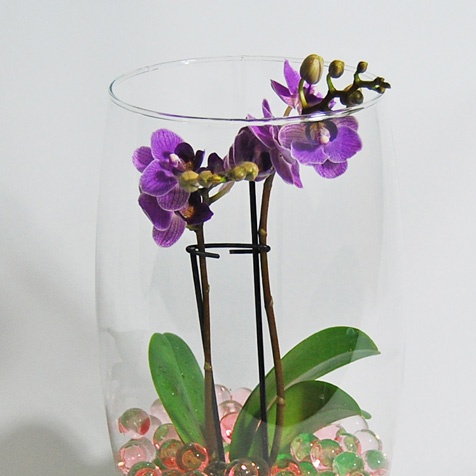 You may be interested in:
You may be interested in:Plant reviews
Orchid lovers share their experiences and provide feedback on orchids.
Inna, 23 years old
Most of the flowers I have are Cumbria and orchids of the oncidium group, and all the rest are phalaenopsis. Even when Cumbria does not bloom, I still like them because of the lush foliage that has not wrinkled over time. I have a veilsteekear, burragear, colmonar. They are all beautiful and grow without a hint of illness.
Olga, 52 years old
I concluded that the maintenance of Cumbria is considered much easier than careful care of the phalaenopsis. If they begin to bloom after stimulation in the form of a change in temperature and frequency of watering for a couple of weeks, then the flowering state of the oncidium group pleases with each bulb. The shape of their flowers resembles an asterisk, and the color is so different that it is impossible to cling to just one thing.
Anastasia, 40 years old
My orchid is almost a year old. In general, Cumbria is not a species, but a hybrid crossed from several varieties. Their flower is very beautiful with a bright color and dark green, large leaves. I bought a Cumbria flower in a closed system at a sale that had a yellowed appearance, but with just one bulb.
Cumbria orchid has become a popular hybrid due to its unpretentiousness. Growing can be considered a simple matter, and the flower itself over time becomes the decoration of many window sills. But it is worth considering that for a flowering species of orchid, she needs care. Subject to the rules and proper care, Cambria will bloom for a very long time.

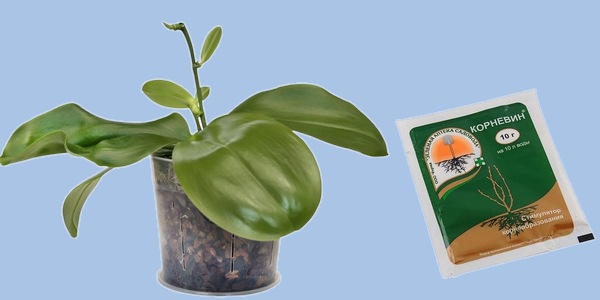
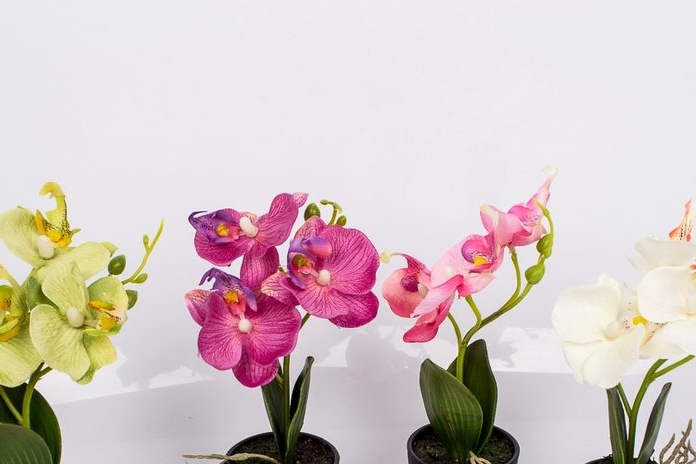
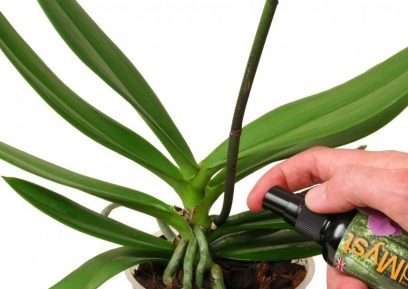
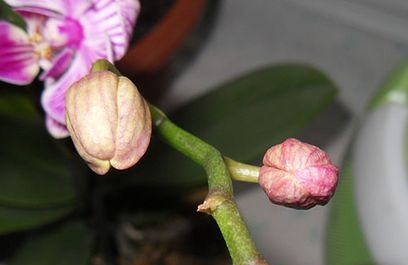 Reasons why orchids fall flowers and what to do
Reasons why orchids fall flowers and what to do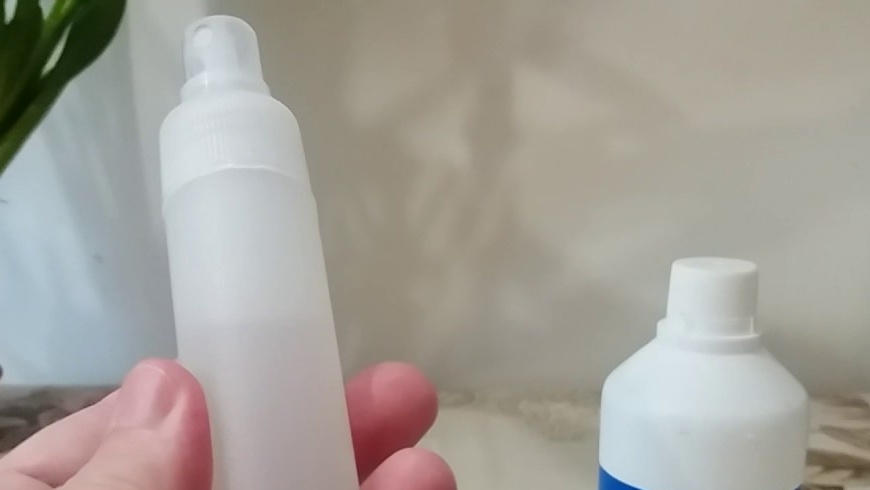 How to use hydrogen peroxide for orchids and why
How to use hydrogen peroxide for orchids and why Midges are wound up in the orchid: effective ways to get rid
Midges are wound up in the orchid: effective ways to get rid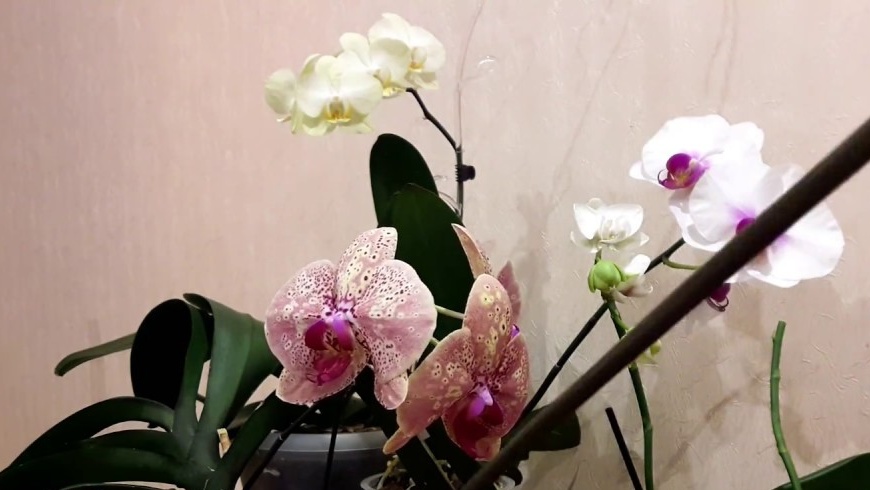 Is it possible to transplant an orchid during flowering
Is it possible to transplant an orchid during flowering